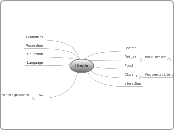DISCLAIMER: THIS MIND MAP IS BASED ON THE UNIT 2 OF THE MASTER IN BILINGUAL EDUCATION OF UNIR. THESE IDEAS ARE NOT ORIGINALLY PRODUCED BY ME.
BILINGUAL EDUCATION PROGRAMS
BILINGUALISM AND BILINGUAL EDUCATION
Bilingual education is the use of two languages in the instruction and assessment of learners (García 2009).
APPROACHES TO BILINGUAL EDUCATION
An educational approach to teaching and learning where subject are taught through the medium of a non-native language. (TKT: CLIL handbook)
COMMUNICATION
Using language to learn whilst learning to use language. (Coyle, 1999)
CULTURE
Exposure to alternative perspectives and shared understandings, which deepen awareness of otherness and self. (Coyle, 1999)
COGNITION
Developing thinking skills which link concept formation (abstract and concrete), understanding and language (Coyle, 1999)
CONTENT
Progression in knowledge, skills and understanding related to specific elements of a defined curriculum. (Coyle, 1999)
CONCURRENT
Use of code-switching as a learning tool, both by students
and teachers. The use of multiple languages in the
classroom is not penalized. (Jacobson, 1990) This model is similar to Translanguaging since the use of multiple languages is encouraged in other to acquire an additional language.
TRANSLANGUAGING
Translanguaging is the act performed by bilinguals of accessing different linguistic features or various modes of what are described as autonomous languages, in order to maximize communicative potential. Ofelia García (2009: 140) Translanguaging is about communication, not about language itself.
CODE-SWITCHING
When a bilingual speaker mixes two languages or codes at word level or at sentence level. i.e Let's go to la playa or Esta comida esta muy yummy.
HETEROGLOSSIC
It is related to plurilingualism and tranlanguing.
DYNAMIC
...allows the simultaneous coexistence of different languages in communication, accepts translanguaging, and supports the development of multiple linguistic identities to keep a linguistic ecology for efficiency, equity and integration, and responding to both local and global contexts. (Garcia, 2009)
CLIL
CLIL models typically consist in teaching and learning curricular content through the use of an additional language (Coyle, 2007; San Isidro, 2010).
POLY-DIRECTIONAL
It has to do with the presence in schools of students with different L1 or language profiles, who have to develop different language practices because of the multilingualism of their social context.
RECURSIVE
Revitalization of minority languages.
DEVELOPMENTAL
In this model minority language children are instructed in their L1, home, native or heritage language. The majority language is included in the curriculum and is taught as a foreign language. This model is similar to Maintenance model since it aims to preserve minority languages.
This model is applied to revitalized languages that are in danger or that have been suppressed. An example to this model would be languages like taiwanese, creole and indigenous languages.
This model is different to the immersion in both Additive (which learning and L2 or FL without losing the L1) and Subtractive models (which is learning a majority L2 through the L1.
MONOGLOSSIC
It sees languages as separate entities, they don't connect.
SUBTRACTIVE
Its goal is to replace the L1 or takeaway proficiency in the L1 to establish the L2 or dominant language.
In this approach the L1 is used as a vehicle to learn the L2 during the early stages of acquisition, however as proficiency is gained in the L2 the L1 is left behind.
Not to be confused with the immersion in the Additive approach.
SUBMERSION
The instruction is carried out in a majority L2, but the student speaks minority L1. This is mostly related to sink or swim programs in which the learner acquires a dominant language and consequently loses his/her L1.
ADDITIVE
The aim is to develop proficiency in two languages, the languages in this approach are compartmentalized and kept separated.
IMMERSION
Students is exposed to monolingual environment or context to learn the L2 or dominant language without losing or subtracting proficiency in his L1.
There are level of immersion to this model:
- Early Immersion: Usually in Pre-school.
- Delayed Immersion: Primary or Elementary school-
- Total immersion: The curriculum is taught 100% in the FL.
- Partial Immersion: 50% up to 90% of the curriculum is taught through the FL.
PRESTIGIOUS
Students learn through two prestigious or languages with international prestige, which are kept separate during the instruction to obtain benefits from the market social interaction. i.e learning Chinese and English. This kind of model is common among politologist, international agents or managers, ambassadors or diplomats.
MAINTENANCE
Preserve minority L1 spoken at home during the acquisition process of the majority language.
LENGUAGE POLICIES
Its roles are basically to:
- To preserve some languages
- to promote bilingualism,
- or to favor certain foreign languages over others.
LENGUAGE POLICIES IN EDUCATION
Determine the status or role of the language in the school.
- Language in the curriculum
- Number of our in the curriculum
- Status: Vehicular or Fl.









